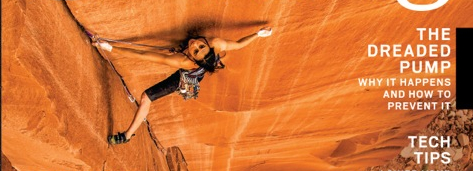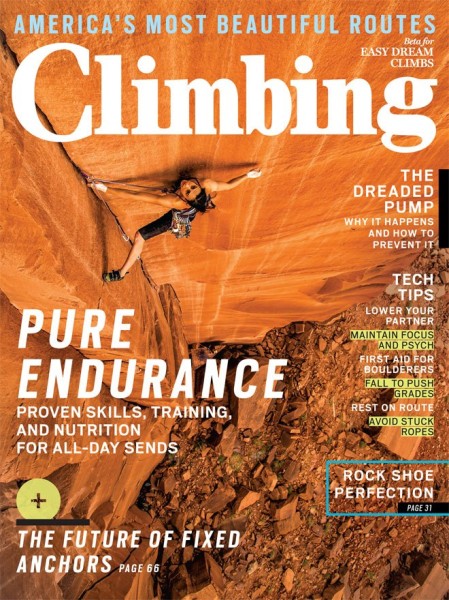
Training for Endurance
Endurance Training
Hey Steph I had a question about training. First of all let me start by saying I am a big fan. Your climbing is very inspiring and I enjoyed your book. I started climbing about a year ago at the age of 33. After a divorce and several years of alcohol abuse I needed a new start and a healthier lifestyle. I started visiting a local climbing gym and fell in love with climbing. I reconnected with an old friend and we agreed to start climbing. But soon this was not enough for me and I began to venture outdoors. I met a few people on mountainproject.com and soon found a new love which was rock. 13 months later and I am leading 5.10 and starting to venture into trad and multipitch. The problem is I have hit a major plateau. Mostly endurance issues on overhanging routes. I’ve adopted the name The Take Master from many of my friends. Of course most of them are young 20 somethings strong and carefree with a few years of climbing under their belts. I try to hit the gym in between climbs and live a relatively healthy lifestyle. Climb indoors or outdoors at least 1 time per week (my gym has 60 ft lead walls) and run a couple of miles a day or two a week. Any advice on ways to improve endurance and not get so pumped? I’m open to diet tips as well as physical training and yoga if you think this would help. Thanks in advance and keep on being awesome!
Jon

Hi Jon,
Thanks for the great question! I really like endurance climbing, and find it one of the most enjoyable feelings to be able to hang on and keep going–equally as enjoyable as getting pumped and telling “take” is not enjoyable! Perhaps the best and the worst thing about endurance is that your endurance level is directly related to training for it.
The key to having better endurance is being able to recover while on the climb. Rather than looking at a pitch as one long stretch of climbing, start looking at it as different sections broken by rest-able stances. (This is one reason I’m also going to recommend you do some yoga, but more on that later.)
Even before you leave the ground, look up at the route. If it’s in the gym, see if you can spot the biggest holds on it. If it’s outdoors, look for areas with small ledges, dihedrals or obviously bigger foot stances. You may be able to predict some rest stances even before leaving the ground. If you can find rests on the route, suddenly you only need to climb hard for a short section before you get to your recovery place, effectively breaking up the route into many small sections instead of one big enduro-thon.
The next issue is how to recover at those stances. Sometimes the rest is merely one large hold on an overhanging face, rather than a nice hands-off stem stance–although the nice hands-off stem stance can be unusable if you can’t stretch your legs enough, or if your calves start shaking with Elvis leg. So I recommend that you focus on two things, to cover both bases, 1: training your forearms to recover better on large holds, and 2: practicing some very simple and basic yoga poses, on your own, to get used to relaxing your muscles in unfamiliar positions. Your body will remember this and become better at it.
To train for recovery, you simply need to make a point of stopping and shaking out every time you reach a decent hold. A long traverse wall in a gym is great for this, or doing toprope laps on the steep wall in your gym. I even do it outside when I’m warming up on easy sport climbs, just because it feels good and I find it relaxing. Climb normally until you get to a big hold (or ideally, two big holds). Now stop, even if you’re not desperately pumped yet, and drop one arm to your side. Shake it, rotate it up over your head, put your hand on your thigh to flex your forearm, breathe, and keep shaking and letting your arm hang. When your other arm gets too tired of holding on alone, switch arms and start shaking and de-pumping the other arm. Keep switching arms, and pay attention to how long you are letting go with each hand. In the most pumped scenario, you might only be able to let go of each hand for a second at a time. But as you keep switching, you’ll get a couple more seconds of rest each time on each one. The key is to be patient with it, and to build up enough recovery strength that you can be patient with it. Ideally, you’ll be letting go and depumping each arm for a little longer each time, and eventually for many seconds each one, allowing each to recover more and more in the switch off. When you feel that both forearms are less pumped (in the best case, completely not pumped now), keep climbing to the next good holds. Then do it again. As you get in the habit of climbing this way, and as you build up your ability to de-pump and recover one arm at a time, you will find that you can fight your way through hard/desperate climbing and still recover very well at jugs or rest stances. It’s okay to give 110% when you know you can get it all back as soon as you get a decent hold. This is a great technique to use for onsighting and for endurance redpoints, and it makes for what I find a really enjoyable, flowing climbing style.
Along the same lines, practicing a few yoga poses in the morning will train your muscles to let go and relax in odd positions. If you can bunch yourself up in a dihedral with one arm and one leg podded out to each side and eventually get comfortable there, you will be able to emerge rested and keep climbing. I recommend just choosing a few simple poses: the sun salutation, tree pose, warrior poses, for example, along with a few seated poses after that, and practicing them in the mornings. Eventually you can learn a few more and add those in as well. Remember, practicing yoga does not mean immediately looking like just like the yogis in the yoga pictures who do nothing but yoga all day! Especially for athletes, you may find that your muscles are not so flexible. Don’t force anything, just work on stretching gently and using the yoga photos and drawings as guides for yourself, to practice the different poses. Over time, your body will get more comfortable with relaxing in awkward positions, and you may even find that you notice this when trying to relax your forearms during your shake-out rests.
A final note is that you can also help your endurance by increasing your power. If you become more powerful, when you get on an endurance route, every single move feels that much easier than when you were less powerful, and the pump does not add up as much. So don’t be afraid to keep working on your power as well.
Enjoy!
Steph








Very useful post. Indeed a must share for the people looking to improve and strengthen their endurance and other capabilities.
http://www.yotopia.co.uk
[…] endurance–there’s no mystery. If you train for it, you’ll have it. I wrote a lengthy post about this not too long ago. It’s amazing how when the endurance starts to build, holds that were […]
Thanks so much. This was very encouraging. I too want to improve my overhang endurance. I like that you said “But as you keep switching, you’ll get a couple more seconds of rest each time on each one (arm).” and “As you get in the habit of climbing this way, and as you build up your ability to de-pump and recover one arm at a time, you will find that you can fight your way through hard/desperate climbing and still recover very well at jugs or rest stances.” I’m going to try this and see if I can de-pump better. If I get a full rest, say outside on a ledge or stemming in a dihedral outside or in the gym, it definitely breaks the route into more manageable pieces, but I find it hard to recover on overhang that keeps going where I always am hanging on with at least one arm, even if I shake out on jugs, I often have takes on difficult overhang because I get too pumped. I am much stronger on face walls. Pretty strong on overhang, but my endurance runs out. I am going to try this de-pumping on jugs and give myself more time. Be patient. Keep switching arms and see if the switching time increases and the pump decreases. Thanks for a tip I can try. 😀
[…] CLICK HERE: Training for Endurance […]